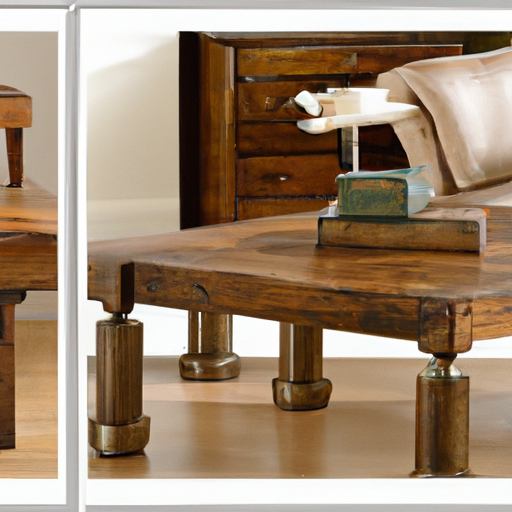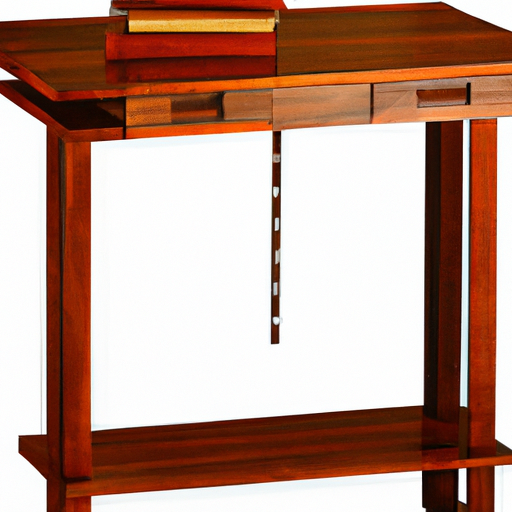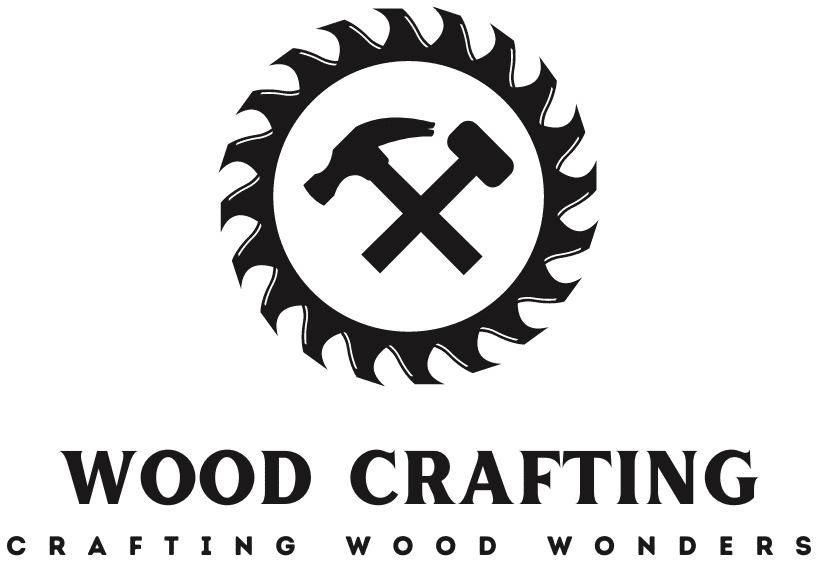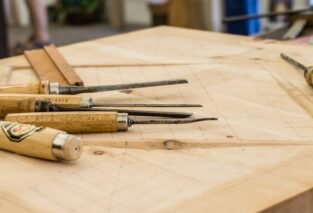In this article, we will explore different ways you can add metal accents and hardware to your woodworking projects. You’ll learn about the various types of metal finishes and how they can complement different wood types. We’ll also discuss the different types of hardware options available, such as handles, hinges, and knobs, and provide tips on how to choose the right ones for your project. By the end, you’ll feel confident in incorporating metal accents and hardware into your wood projects to enhance their aesthetic appeal. Whether you’re a seasoned woodworker or just starting out, adding metal accents and hardware to your wood projects can elevate the overall look and functionality. Metal elements can bring a touch of elegance, durability, and versatility to your creations. In this article, we will explore different types of metal accents and hardware, discuss the process of incorporating them into wood projects, and provide inspiring examples to help unleash your creativity.

Choosing the Right Metal Accents and Hardware
Understanding the Different Types of Metal Accents
Before diving into incorporating metal accents into your wood projects, it’s important to understand the different types of metal accents available. Some popular options include:
-
Nailheads: These small decorative studs can be used to create patterns or add detail to your woodwork. They come in various sizes, shapes, and finishes, allowing you to customize your design.
-
Corner Braces: Corner braces provide structural support and add a decorative touch to your wood projects. They are often used in furniture construction to reinforce corners and prevent warping or sagging.
-
Medallions: Medallions are decorative embellishments that can be affixed to the surface of your woodwork. They come in various designs and sizes, allowing you to add a focal point or create visual interest.
-
Handles and Knobs: Handles and knobs are essential hardware elements for cabinets, drawers, and doors. They come in different materials, such as brass, stainless steel, or copper, and can be chosen to complement your overall design aesthetic.
Exploring Various Hardware Options
In addition to metal accents, incorporating metal hardware into your wood projects can greatly enhance their functionality and durability. Here are some hardware options to consider:
-
Hinges: Hinges allow for movement and flexibility in furniture pieces such as doors, cabinets, and lids. Choosing the right hinges ensures smooth operation and adds stability to your woodwork.
-
Locks and Latches: Locks and latches provide security and convenience to cabinets, drawers, and boxes. They come in various styles, including traditional locks, magnetic locks, and push-to-open mechanisms.
-
Drawer Slides: If you’re building a drawer, incorporating drawer slides can make opening and closing smooth and effortless. They come in different types, such as side-mount, under-mount, or center-mount, and can be chosen based on your specific project requirements.
Considering the Style and Functionality
When selecting the right metal accents and hardware for your wood projects, it’s essential to consider both the style and functionality. The metal elements should complement the overall design aesthetic and enhance the functionality of your woodwork.
For example, if you’re working on a rustic farmhouse-style piece, you might opt for iron or bronze hardware for an authentic and charming look. On the other hand, if you’re aiming for a modern and sleek design, stainless steel or brushed nickel hardware can add a contemporary touch.
Consider the specific needs of your project. If you’re building a storage cabinet, sturdy hinges and latches that can handle heavy loads are crucial. If you’re constructing a jewelry box, delicate and intricate handles or knobs might be more fitting.
Preparing Your Wood Project
Before incorporating metal accents and hardware into your wood project, it’s important to properly prepare the wood. This preparation includes assessing the project requirements, measuring and marking the wood, and creating slots or holes for metal inserts.
Assessing the Project Requirements
Start by assessing the specific requirements of your wood project. Consider the size, shape, and purpose of your project, as well as the weight-bearing needs and the desired aesthetic.
For example, if you’re building a dining table, you’ll need to evaluate the dimensions and weight capacity required. This will help you determine the appropriate hardware, such as heavy-duty corner braces or table legs with adjustable levelers for stability.
Measuring and Marking the Wood
Accurate measurements are crucial when incorporating metal accents and hardware into your wood projects. Use a tape measure or ruler to measure the dimensions of your wood pieces, taking into account any additional space required for metal inserts or hardware.
Once you have the measurements, mark the areas where the metal accents or hardware will be placed. Use a pencil or marking tool to create clear and precise guidelines, ensuring proper alignment and symmetry in your design.
Creating Slots or Holes for Metal Inserts
To securely attach metal accents or hardware to your wood project, you may need to create slots or holes for them. This step can be done using various woodworking techniques, such as drilling, chiseling, or routing, depending on the specific metal accents or hardware you are using.
For example, if you’re adding nailheads to your woodwork, you can create pilot holes using a small drill bit or awl. This will help guide the nails and prevent the wood from splitting.
Adding Metal Accents to Wood
Now that your wood project is properly prepared, it’s time to add the metal accents. This involves choosing the right placement, determining the size and shape, and securing the metal accents into the wood.
Choosing the Right Placement
Consider the overall design and purpose of your wood project when determining the placement of metal accents. Determine the areas where metal accents will add visual interest, highlight certain features, or provide structural support.
For example, if you’re building a coffee table with a wooden top, you might add metal corner braces to reinforce the corners while adding a decorative touch. You could also incorporate nailheads along the edges for added detail.
Determining the Size and Shape
When selecting the size and shape of metal accents, it’s important to strike a balance between proportionality and functionality. Consider the dimensions and scale of your wood project to ensure that the metal accents complement the overall design.
For larger wood projects, such as dining tables or bookshelves, larger and more prominent metal accents can be used. For smaller projects, such as jewelry boxes or picture frames, smaller and more delicate metal accents might be more appropriate.
Securing the Metal Accents into Wood
To secure the metal accents into the wood, you’ll need to choose the appropriate fastening method. This can include using small nails, screws, or adhesives specifically designed for woodworking.
For example, if you’re attaching medallions to your woodwork, you can use wood glue or epoxy adhesive to bond them securely in place. For corner braces or handles, screws or bolts can be used to ensure a sturdy connection.
Incorporating Metal Hardware
In addition to metal accents, incorporating metal hardware into your wood projects can greatly enhance their functionality and durability. Here are some steps to consider when incorporating metal hardware:
Selecting the Appropriate Hardware Pieces
When choosing metal hardware pieces, it’s important to consider their compatibility with your wood project. Select hardware that matches the style and aesthetic of your woodwork, and ensure that they are designed for the specific purpose you require.
For example, if you’re installing drawer slides, choose ones that are suitable for the weight capacity and dimensions of your drawers. Consider the type of slide, whether it’s side-mount, under-mount, or center-mount, and ensure that it fits seamlessly into your woodwork.
Installing and Mounting the Hardware
Proper installation of metal hardware is crucial for its functionality and longevity. Follow the manufacturer’s instructions and use appropriate tools for installing and mounting the hardware to your wood project.
Ensure that you measure and mark the correct locations for installing the hardware, taking into account any necessary clearance or spacing requirements. Use a level or straight-edge to ensure proper alignment, and make sure to secure the hardware tightly to prevent any movement or wobbling.
Ensuring Proper Alignment and Symmetry
When incorporating multiple pieces of metal hardware into your wood project, it’s important to ensure proper alignment and symmetry. This will create a visually pleasing and cohesive look.
Take accurate measurements and use a ruler or marking tool to create guidelines for alignment. Use a level to ensure that the hardware is straight and evenly spaced. Take your time during installation to ensure precision and attention to detail.

Blending Metal and Wood Aesthetically
When incorporating metal accents and hardware into your wood projects, it’s important to create a harmonious design that blends well with the wood. Here are some tips for achieving an aesthetically pleasing result:
Creating a Harmonious Design
Consider the overall style and aesthetic of your wood project when selecting metal accents and hardware. Choose metal elements that complement the color, grain, and texture of the wood, creating a harmonious and cohesive look.
For example, if you’re working with dark walnut wood, brass or copper accents can add warmth and richness to the design. If your wood project has a lighter tone, stainless steel or brushed nickel hardware can provide a modern and contemporary feel.
Experimenting with Contrasting Colors
While creating harmony in your design is important, don’t be afraid to experiment with contrasting colors to add visual interest. A pop of color or a different metallic finish can create a focal point or add a unique touch to your woodwork.
For example, if you’re working on a rustic-style piece, you might consider adding black or oil-rubbed bronze hardware to create contrast against lighter wood tones. This can create a dramatic and eye-catching effect.
Achieving a Balanced Visual Appeal
When incorporating metal accents and hardware into your wood projects, strive for a balanced visual appeal. Avoid overwhelming your design with too many metal elements, as this can detract from the natural beauty of the wood.
Consider the size, quantity, and placement of metal accents and hardware to create a balanced and visually pleasing composition. Step back and assess your work periodically to ensure that the metal accents do not overpower the wood.
Maintaining and Protecting Metal Accents
Once you’ve successfully incorporated metal accents and hardware into your wood projects, it’s important to maintain and protect them to ensure their longevity. Here are some tips for cleaning, polishing, applying protective coatings, and preventing corrosion and rust:
Cleaning and Polishing Metal
Regular cleaning and polishing can keep your metal accents and hardware looking their best. Use a soft cloth and a mild cleaning solution to gently remove dirt and smudges from the surface of the metal.
Avoid using abrasive cleaners or rough materials that can scratch or damage the metal. Instead, opt for non-abrasive cleaners specifically designed for metal surfaces. Follow up with a polish to restore shine and remove any remaining tarnish or oxidation.
Applying Protective Coatings
To protect metal accents and hardware from wear, tear, and corrosion, consider applying a protective coating. Clear lacquer or polyurethane finishes can provide a protective layer that shields the metal from exposure to moisture and other elements.
Before applying any coatings, ensure that the metal surfaces are clean and dry. Follow the manufacturer’s instructions for the specific protective coating you are using, and apply multiple thin coats for optimal protection.
Avoiding Corrosion and Rust
To prevent corrosion and rust on your metal accents and hardware, take proactive measures to minimize exposure to moisture and humidity. Avoid placing wood projects with metal elements in damp or humid environments.
If your wood project is exposed to moisture, promptly wipe down any metal surfaces and dry them thoroughly. Consider applying a rust-inhibiting product, such as a wax or specialized metal protectant, to further protect against corrosion.
Exploring Innovative Metal-Wood Combinations
Incorporating metal accents and hardware into your wood projects offers endless opportunities for creativity and innovation. Here are some ideas for exploring innovative metal-wood combinations:
Mixing Different Metal Accent Styles
Create visual interest by mixing different styles of metal accents within a single wood project. Combine modern, sleek hardware with vintage-inspired nailheads or medallions to create a unique and eclectic look.
Experiment with mixing different metal finishes, such as brass with stainless steel or copper with blackened iron. This can add depth and texture to your woodwork, making it a truly one-of-a-kind piece.
Combining Various Wood Types
Incorporate multiple types of wood into your project to create a striking contrast with the metal accents and hardware. Combine different wood species with varying grains, colors, and textures to add depth and dimension.
For example, you could use a light-colored wood for the main structure of a piece and add darker-toned wood as an accent or inlay. This creates a visually appealing contrast that highlights both the wood and metal elements.
Pushing the Boundaries of Design
Don’t be afraid to push the boundaries of design when incorporating metal accents and hardware into your wood projects. Experiment with unconventional shapes, sizes, and arrangements to create a truly unique and stunning piece.
Consider incorporating abstract metal elements, such as sculptural handles or custom-designed metal inlays, to add an artistic touch to your woodwork. This allows you to showcase your creativity and bring your vision to life.
Enriching Wood Projects with Functional Metal Elements
In addition to enhancing the aesthetic appeal of your wood projects, metal accents and hardware can also enrich them with functional elements. Here are some ways to incorporate functional metal elements into your woodwork:
Enhancing Durability and Stability
Metal can significantly enhance the durability and stability of your wood projects. Incorporate metal elements, such as corner braces or reinforcing plates, to strengthen joints, prevent warping, and increase overall structural integrity.
For example, if you’re constructing a bookshelf, adding metal shelf brackets can provide added support and prevent sagging over time. This ensures that your wood project will withstand the test of time and heavy use.
Adding Practical Functionality
Metal hardware, such as hinges, locks, and drawer slides, can add practical functionality to your wood projects. Choose hardware designed for smooth operation and durability to enhance the usability and convenience of your woodwork.
Whether you’re building a cabinet with hidden hinges that offer a clean and seamless look or incorporating soft-close drawer slides to prevent slamming, the right hardware can greatly improve the functionality of your project.
Integrating Modern Technological Features
Incorporating metal accents and hardware into your wood projects also allows for the integration of modern technological features. For example, you could incorporate metal accents with built-in USB or wireless charging capabilities into a desk or nightstand.
Consider incorporating speakers, LED lights, or cable management solutions into your woodwork to accommodate modern technology and enhance the overall user experience.
Inspiring Examples of Metal Accents in Wood Projects
To further inspire your creativity, here are some examples of how metal accents can be incorporated into wood projects:
Showcasing Furniture Enhancements
In furniture pieces such as tables, chairs, or beds, metal accents can transform a simple design into a stunning focal point. From ornate metal inlays on tabletops to intricate metal scrollwork on chair backs, metal accents can add a touch of luxury and sophistication to your furniture.
Highlighting Decorative Metal Details
In smaller wood projects such as picture frames, mirrors, or jewelry boxes, metal accents can be used to highlight decorative details. For example, adding metal corner brackets to a picture frame can enhance its charm and provide added strength.
Examining Architectural Applications
Architectural applications of metal accents in wood projects can be seen in staircases, doors, or trim work. Metal balusters or handrails on staircases can add a modern or traditional touch, while metal rosettes or decorative trim can elevate the overall architectural design.
Conclusion
Incorporating metal accents and hardware into your wood projects opens up a world of possibilities. Whether you’re aiming to enhance the aesthetic appeal, add functionality, or push the boundaries of design, the right metal elements can take your woodwork to the next level. By carefully selecting metal accents and hardware, properly preparing the wood, and maintaining and protecting the metal elements, you can create unique and captivating pieces that showcase your creativity. So, unleash your imagination, experiment with different metal-wood combinations, and enjoy the journey of transforming your wood projects with metal accents.





